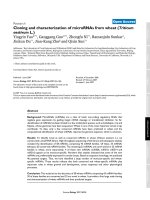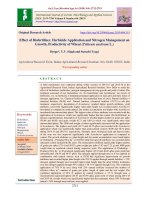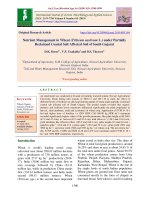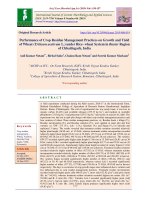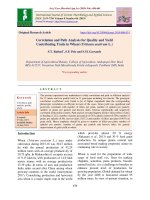Effect of plasma and nanochitosan treatment on growth indices of wheat (Triticum aestivum L.) seeds
Bạn đang xem bản rút gọn của tài liệu. Xem và tải ngay bản đầy đủ của tài liệu tại đây (383.49 KB, 7 trang )
Int.J.Curr.Microbiol.App.Sci (2019) 8(10): 479-485
International Journal of Current Microbiology and Applied Sciences
ISSN: 2319-7706 Volume 8 Number 10 (2019)
Journal homepage:
Original Research Article
/>
Effect of Plasma and Nanochitosan Treatment on Growth Indices of
Wheat (Triticum aestivum L.) Seeds
Himangini Joshi1*, Rajeew Kumar1, D. S. Pandey1 and Chetan Jariwala2
1
Department of Agronomy, G B Pant University of Agriculture & Technology, Pantnagar263145, Uttarakhand, India
2
Institute for Plasma Research, Bhat, Gandhinagar-382428, Gujarat, India
*Corresponding author
ABSTRACT
Keywords
Nanochitosan
treatment, Plasma
treatment, Seed coat
etching, Target
action
Article Info
Accepted:
07 September 2019
Available Online:
10 October 2019
A water culture experiment was conducted with eight treatments; these were
absolute control, plasma seed treatment with 2, 4, 6, 8 and 15 minutes,
nanochitosan (50 ppm) and nanochitosan (50 ppm) integration with NPK mixture
at G B Pant University of Agriculture & Technology, Pantnagar during rabi
season year 2017-18. While pot experiments were conducted with twelve
treatments; which were control with full dose of fertilizer, nanochitosan (50 ppm)
treatment with full dose of fertilizer, plasma treatment with full dose of fertilizer,
control with 3/4th dose of fertilizer, nanochitosan (50 ppm) treatment with 3/4th
dose of fertilizer, plasma treatment with 3/4th dose of fertilizer, control with ½
dose of fertilizer, nanochitosan (50 ppm) treatment with ½ dose of fertilizer,
plasma treatment with ½ dose of fertilizer, control with no fertilizer, nanochitosan
(50 ppm) treatment with no fertilizer and plasma treatment with no fertilizer.
Maximum root length, shoot length, root and shoot dry weight were obtained in
seed treated with 6 minute plasma treatment seeds under in vitro condition,
whereas pot culture morphological indices were reported higher with full dose of
fertilizer along with nanochitosan (50 ppm) treatment.
Introduction
Optimum use of mineral nutrients (fertilizers)
by crops is essential for sustainable
agricultural production. With increasing world
demands for food and energy, this is set to
become an ever increasing priority. Fertilizers
are costly to produce and apply, both
financially and environmentally. There is an
absolute requirement to maximize efficiency
(Hawkesford, 2012). This can be achieved by
use of upcoming new technologies such as
plasma
and
nanotechnology.
Plasma
denominates as a state with a high, unstable
energy level that has more or less equal
479
Int.J.Curr.Microbiol.App.Sci (2019) 8(10): 479-485
number of positive and negative charged
particle or reactive species, created when gas
become ionized. When plasma comes in
contact with seed coat layer, the surfaces get
modified and change their important
properties, such as the surface etching,
wettability of surface, rate of imbibition etc.,
which helps in accelerating the physiological
processes of plants. In addition, together with
surface etching effect results in increased
permeability towards seed coat, surface
modification of the seed coat, stimulated seed
germination and growth of seedling.
Nanotechnology has proved its worth in
agriculture. It is a powerful technology which
can have ability of creating massive changes
in food and agriculture system. Nanofertilizers
release the nutrients as per the requirement of
crop, preventing from premature interaction
with soil as well as water environment and the
microorganisms; the released nutrients directly
assemble into the plant system effectively.
These unique characteristics can improve the
nutrient use efficiency of the crop (DeRosa et
al., 2010). Chitosan nanoparticles have good
association and loading efficiency values of a
model substance which is showing its ability
as a nano carrier for nutrient delivery systems
(Aiping et al., 2006) and also act as a slow
release fertilizers that is only a bit soluble in
water or slowly broken down by microbial
action (Prasad et al., 2009). Thus, the rate of
nutrient liberation from slow release fertilizers
is related to their water solubility,
microbiological degradation and chemical
hydrolysis and NO3 -N leaching decreased by
applying slow release fertilizers coated with
nano-materials. A plasma seed treatment
bestows to seed germination enhancement and
raises the plant productivity. Nanochitosan get
easily applied to seed’s surface and enter the
nano pores of cell wall and cell membrane of
the seed cause increase in harvest index, crop
index and mobilization index of yield factors,
as compared with factor treated with normal
non-fertilized and normal fertilized (Aziz et
al., 2016) seeds.
Materials and methods
Plasma seed treatment
The wheat seeds have been treated in a
capacitively coupled plasma reactor consists
of Stainless Steel (SS) chamber with rotary
pump for creating necessary sub-atmospheric
vacuum (Fig. 1). A Petri dish with wheat seeds
was put on the grounded lower electrode (size
120 mm) made of SS for plasma treatment
experiments. The plasma treatment of wheat
seeds have done using air plasma formed
using radio frequency supply (13.56 MHz)
with treatment time 2, 4, 6, 8 and 15 minutes
with fixed 50 watts coupled power and 0.7
mbar pressure. These plasma treatments were
done at Institute for Plasma Research,
Gandhinagar, Gujarat, India.
Scanning electron microscopy analysis
The surface morphology of plasma treated and
untreated wheat seeds are investigated by
Scanning Electron Microscopy (SEM)
analysis. The treated and untreated wheat
seeds surfaces were analyzed using High
Vacuum Mode (HVM) operation of SEM in
detail without damaging seed coat surface
during analysis.
Nano chitosan seed treatment
Nanochitosan purchased from nanoshell,
Wilmington (USA), that have C6H11NO4
(molecular formula), > 99 % purity, 1.4
specific gravity, cost price 1000 Rs/gram,
white appearance and 50ppm of it used for
experiment purpose. For preparing 50 ppm
nanochitosan
solution
weighed
the
nanochitosan at 0.050 gram or 50 mg and
blended in 1 liter distilled water with the help
of magnetic stirrer for 30 minutes, for equal
480
Int.J.Curr.Microbiol.App.Sci (2019) 8(10): 479-485
distribution of it into the distilled water. The
seeds of wheat were immersed in a sodium
hypochloride solution for 2 minutes for
surface sterilization of seeds then they were
soaked in nanochitosan 50 ppm solution for 3
hours. Treated seeds were shade dry over
muslin cloth for 24 hours. This process was
performed one day before the sowing of wheat
seeds.
Water culture and plasma seed treatments
Water culture experiments of 15 days were
conducted in moorashige and skoog media for
plasma treated wheat seeds. The experiments
were laid out in completely randomized design
(CRD) having three replications of plasma
treated
wheat
of
HD-2967
variety.
Morphological indices for water culture
experiment viz., germination percentage, root
length (cm), shoot length (cm), fresh weight
(g) and dry weight (g) were recorded during
experiments. All the data were subjected to
one way analysis of variance (ANOVA), using
the STPR statistical package. For comparison
of means, the Duncan’s multiple range tests (p
< 0.05) were used in this study.
Pot experiment
The pot experiment was conducted during the
Rabi season, year 2017 at the Norman E.
Borlaug crop research centre of G.B. Pant
University of Agriculture and Technology,
Pantnagar, Uttarakhand. The pots were filled
with soil taken from the N.E. Borlaug crop
research centre where field experiment was
conducted and pot experiment also done in
open field condition. The soil of experimental
site was silty clay loam in nature with neutral
pH of 7.4 and EC of 0.419 dS/m medium in
organic carbon (0.72%), low in available
nitrogen (216.25 Kg/ha), but available
phosphorus (12.14 Kg/ha) and potassium was
in medium range (139.08 Kg/ha). The
experiment was laid out in factorial CRD
design with three replications. The treatments
were included four different doses of fertilizer
in main plot and seed treatments in subplot.
The treatments comprises four doses of
recommended dose of fertilizers (150:60:40
NPK Kg/ha) viz; Full dose of fertilizer (N1),
3/4 dose of fertilizer (N2), ½ dose of fertilizer
(N3) and without use of fertilizer (N4) in main
plot and Control / without seed treatment (S1),
Plasma treated seeds (S2) and Chitosan
nanoparticles
(S3)
in
subplot.
The
observations viz., emergence count (%), plant
height (cm), green seeker, tillers/pot were
recorded during experiments. Data was
analyzed using the STPR statistical package.
Results and Discussion
SEM surface analysis of wheat seed coat
HVM-SEM was used to characterize the
modification of surface morphology of wheat
seed coat and results were showed in Figure 2.
Typical mesh structures were clearly observed
on wheat seed coat for untreated seed (Fig. 2
(A)), whereas such mesh structures were
gradually soften with air RF plasma treatment
and for 6 min treated shown in Figure 2 (B).
While further increase in plasma treatment
time such structures were destroyed and also
cracks (marked with arrows) were formed on
seed coat confirmed the degradation of seed
coat (Fig. 2 (C)). Such surface modification
may improve the water uptake and hence
germination of seeds in case of 6 min
treatment.
Water culture and plasma seed treatment
Maximum root length and shoot length were
reported with 6 minutes plasma treatment,
which was significantly higher than control, 2,
4, 8 and 15 minutes of plasma treatment (Fig.
3). Their high surface energy helped them to
stimulate early root and shoot development.
481
Int.J.Curr.Microbiol.App.Sci (2019) 8(10): 479-485
These findings were concurrent with the
findings of Aziz et al., (2016).
Similarly, maximum root and shoot dry
weight was obtained with 6 minutes plasma
treatment and at par with 4 minutes plasma but
found significantly higher over remaining
treatments.
This might be possible due to the enhanced the
mobilized seed reserves and seed reserve
utilization efficiency that was the major factor
responsible for early growth and development
of seedling, resulted in high root and shoot
length of the seedlings. Similar results were
also obtained by Ling et al., (2014)
Pot experiment
Full dose of fertilizer along with nanochitosan
revealed maximum emergence of seeds, which
was statistically at par with 3/4th dose of
fertilizer plus plasma for 6 minutes but
significantly higher than other treatments (Fig.
4).
Reason behind that nanochitosan increased the
rate of gibberallic acid, indole acetic acid
(IAA) and reduced mean emergence time.
Similar evidences were also obtained by Shao
et al., (2005). At 30 DAS, full dose of
fertilizer
with
nanochitosan
observed
maximum plant height which was at par with
3/4th dose of fertilizer applied to nanochitosan
seed treatment. Because nanochitosan might
be act as a chelating agent for metals, improve
nutrient use efficiency and overall growth of
plant.
Similar results were also obtained by Yin et
al., (2010). At 60 DAS, Minimum numbers of
tillers/pot observed with no dose of fertilizer.
Full dose of fertilizer plus nanochitosan @ 50
ppm reported maximum tillers per pot
whereas, at par with full dose of fertilizer plus
plasma treatment and 3/4th dose of fertilizer
plus nanochitosan but significantly higher
over other treatments.
It might be due to plasma improved
metabolism of plant that stimulate overall
growth and nanochitosan served as a control
release formulation that helps to exploit
nutrient efficiency which assured the crop
requirement at lower doses.
At 30 DAS, Green seeker reading was found
maximum with full dose of fertilizer plus
nanochitosan @ 50 ppm which was
significantly higher than the other treatments.
It might be due to vigorous growth and more
photosynthesis efficiency of the crop at full
dose of fertilizer with nanochitosan treated
seeds.
These findings can be supported by the results
obtained by Coradini et al., (2010). At 60
DAS, full dose of fertilizer plus nanochitosan
obtained maximum green seeker value which
was at par with 3/4th dose of fertilizer plus
plasma treated seeds for 6 minutes.
Plasma and nanochitosan treated seeds might
have excite photosystem I and II, accumulates
more photosynthetic pigment, improve
relative greenness of the crop. These findings
were concurrent with the findings of Zhang et
al., (2017).
In efficacy assessment of different plasma
treatments, 6 minutes of atmospheric plasma
performed better under water culture
experiment and in pot culture full dose of
fertilizer along with nanochitosan reported
maximum growth which was at par with 3/4th
dose of fertilizer plus plasma.
Thus, plasma and nanotechnology can become
an effective tool for increasing overall
production of wheat (Table 1 and 2).
482
Int.J.Curr.Microbiol.App.Sci (2019) 8(10): 479-485
Table.1 Seedling growth indices of wheat as influenced by seed treatment methods
Treatments
Root
length
(cm)
Shoot length
(cm)
Root dry weight
(g)
Seed treatments
9.5
11.4
Absolute control
Plasma-2 minutes
5.5
8.0
Plasma-4 minutes
Plasma-6 minutes
Plasma-8 minutes
Plasma -15 minutes
Nano-chitosan
Nano-chitosan+
NPK
SEm±
C.D.(P=0.05)
C.V. (%)
11.4
19.5
18.6
12.4
6.5
8.3
0.41
1.47
5.16
Shoot dry weight
(g)
1.1
1.5
2.6
3.6
13.6
14.7
12.3
11.4
14.0
12.8
2.7
2.9
1.4
1.1
2.6
2.5
3.7
2.7
2.6
2.5
3.4
3.0
0.04
0.17
4.57
0.02
0.10
10.47
0.03
0.10
7.32
Table.2 Interaction effect of fertilizer doses and seed treatments on plant growth indices
Treatments
Full dose of
fertilizer
¾ dose of
fertilizer
½ dose of
fertilizer
No
fertilizer
Mean
Emergence count (%)
Control
Plasma
62
Plant height (cm) at 30 DAS
Seed treatments
Control Plasma
Nano
Mean
Chitosan
15.7
18.3
19.2
17.7
Mean
74
Nano
Chitosan
98
58
56
72
62
15.7
17.5
19.1
58
94
62
71
14.3
16.3
20
38
46
35
13.7
20
66
SEm±
70
CD
(P=0.05)
11.04
9.56
19.12
14.9
C.V.
(%)
4.1
-
Fertilizer
Seed treatments
Interaction
3.54
3.07
6.14
78
Tillers/ pot at 60 DAS
Control
Plasma
31
17.4
18.7
15.5
16.9
SEm±
0.03
0.03
0.05
483
Mean
33
Nano
Chitosan
34
29
31
32
30
16.4
24
25
31
26
15.5
14.9
23
24
28
25
18.2
CD
(P=0.05)
0.09
0.08
0.16
26
C.V.
(%)
1.34
-
28
SEm±
31
CD
(P=0.05)
1.16
1.01
2.01
C.V.
(%)
3.68
-
0.37
0.32
0.64
32
Int.J.Curr.Microbiol.App.Sci (2019) 8(10): 479-485
Fig.1(A) Radio frequency plasma treatment system for wheat seed treatment and (B) Closer view
of air RF plasma with wheat seed placed in glass Petri dish
Fig.2 SEM surface images of wheat seed coat taken at 1000X magnification (A) Untreated wheat
seed coat (B) 6 min air RF plasma treated wheat seed coat and (C) 15 min air RF plasma treated
wheat seed coat with arrows were marked on cracks from due to treatment.
Fig.3 Effect of plasma seed treatments (at control, 6-minute, 8-minute and 15-minute) on
seedling growth
Fig.4 Effect of 6- minute plasma and control on emergence and growth
484
Int.J.Curr.Microbiol.App.Sci (2019) 8(10): 479-485
References
Abdel-Aziz, H. M., Hasaneen, M. N. and Omer,
A. M. 2016. Nano chitosan-NPK
fertilizer enhances the growth and
productivity of wheat plants grown in
sandy soil. Spanish journals of
agricultural research, 14 (1): 902.
Aiping, Z., Jianhong, L. and Wenhui, Y. 2006.
Effective loading and controlled release
of
camptothecin
by
Ocarboxymethylchitosan
aggregates.
Carbohydr Polym, 63 (1): 89–96.
Corradini, E., De Moura, M., R. and Mattoso, L.
H. C. 2010. A preliminary study of the
incorporation of NPK fertilizer into
chitosan nanoparticles. Express Polym
Lett. 4(8): 509–515.
DeRosa, M. C., Monreal, C., Schnitzer, M.,
Walsh, R. and Sultan, Y. 2010.
Nanotechnology in fertilizers. Nat.
Nanotechnol. 5: 91-94.
Filatova, I., Azharonok, V., Lyushkevich, V.,
Zhukovsky, A., Mildaziene V. Pauzaite,
G., Zukiene, R. and Malakauskiene, A.
2011. The effect of plasma treatment of
seeds of some grains and legumes on
their sowing quality and productivity.
Rom. J. Phys. 56: 139–143
Hawkesford, M. J. 2012. Improving nutrient use
efficiency in crops. Rothamsted
Research, Harpenden, Hertfordshire,
UK.
/>a0023734.
Ling, L., Jiafeng, J., Jiangang, L., Minchong, S.,
Xin, H., Hanliang, S., and Yuanhua,
D.2014. Effects of cold plasma treatment
on seed germination and seedling growth
of soybean. Scientific Reports, 4: 5859.
Mihai, A. L., Dobrin, D., Magureanu, M., Popa,
M. E., 2014. Possitive Effect of Nonthermal Plasma Treatment on Radish
Seeds. Romanian Reports in Physic, 66
(4):
1110–1117.
Prasad, R. 2009. Efficient fertilizer use: The key
to food security and better environment.
Journal of Tropical Agriculture,
47(1-2): 1-17.
Shao, C. X., Hu, J., Song, W. J. and Hu, W. M.
2005. Effects of seed priming with
chitosan
solutions of different
acidity on seed germination and
physiological characteristics of maize
seedling.
J.
Zhejiang
university
(Agriculture and life sciences), 1: 705708.
Yin, H., Zhao, X., Bai, X. and Du, Y. 2010.
Molecular cloning and characterization
of a Brasica napus L. MAP kinase
involved
in
oligochitosan-induced
defense signaling. Plant Mol. Biol. Rep.
28, 2292–2301.
Zhang, S., Rousseau, A. and Dufour, T. 2017.
Promoting lentil germination and stem
growth by plasma activated tap water,
demineralized water and liquid fertilizer.
RSC Adv. 7 (50): 31244-31251.
How to cite this article:
Himangini Joshi, Rajeew Kumar, D. S. Pandey and Chetan Jariwala. 2019. Effect of Plasma and
Nanochitosan Treatment on Growth Indices of Wheat (Triticum aestivum L.) Seeds.
Int.J.Curr.Microbiol.App.Sci. 8(10): 479-485. doi: />
485
